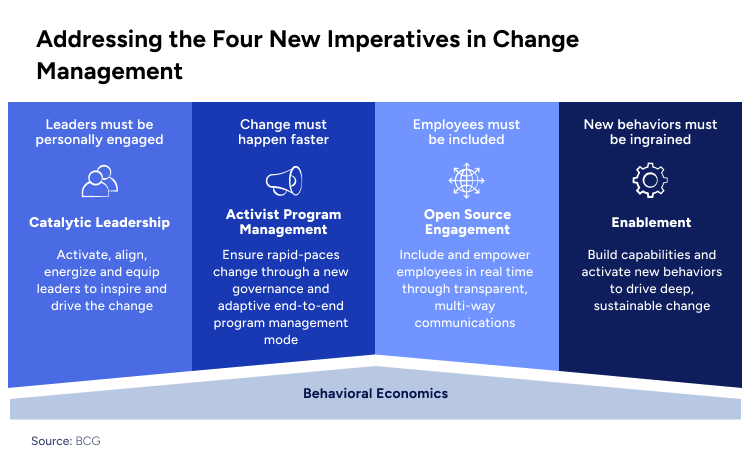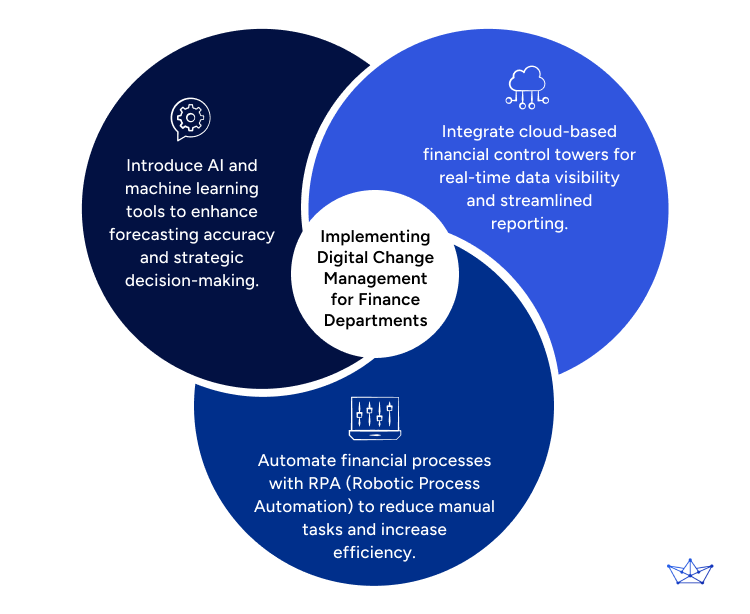Digital Change Management: A Complete Guide



Change management is increasingly seen as inadequate in the face of rapid digital transformation. According to McKinsey research, 70% of change programs fail to achieve their goals.
This high failure rate is primarily attributed to employee resistance to change and a lack of effective management support. This situation is often exacerbated by outdated methodologies that fail to align with data-driven methods. As reported by Harvard Business Review, more than 60% of change management fails due to poor communication and insufficient leadership.

Here is where digital tools are adding value. Digital tools such as Microsoft Power BI, IBM Watson, Jira, WalkMe, have become essential in modern change management. They facilitate real-time monitoring, data-driven decision-making, and automation of repetitive tasks. This enables organizations to drive digital transformations, surpassing traditional change management methods effectively.
Moreover, change management consultants bring the expertise needed to integrate digital tools effectively into change management strategies, ensuring the process is efficient and aligned with the organization’s broader goals.
In this article, we will explore the evolution of change management practices, answering the following questions:
- How are digital tools revolutionizing the way organizations approach change management?
- What are the critical success factors for implementing data-driven change management?
- How can change management consultants help organizations overcome the challenges of digital transformation?
- What specific strategies can finance departments adopt to enhance their digital change management capabilities?
Why Change Management Must Evolve Now
While digital technologies are booming, new value-generating approaches like agile methodologies are gaining momentum. In parallel, companies are looking to create a more flexible workforce driven by the need to implement cost-cutting measures. As a result, traditional change management is no longer sufficient.
In fact, frameworks such as ADKAR and Kotter’s 8-Step Process all provide a functional “skeleton” to drive change. However, they tend to be linear and focus on individuals. Nowadays, companies are increasingly adopting approaches that provide real-time feedback and support agile decision-making.
These modern approaches must account for the broader, system-wide impacts of large-scale transformations, moving beyond traditional, step-by-step methods to more flexible and adaptive strategies.
A recent study by BCG reports that organizations facing complex transformations must ensure that their change management functions evolve throughout the transformation lifecycle. The role of the change management team should adapt at each phase:
- Serving as a “strategic partner” during the goal-setting phase, to define the overall change scope and strategy.
- Becoming an “enabler of change” during the solution and capability development phase, defining and executing the core of the digital change management program.
- Acting as a “guardian of change” during the implementation and sustained improvement phase, aligning the overall corporate strategy and culture to the change process, and ensuring the essential behaviors are sustained.

With 81% of companies reporting an increasing use of agile methodologies since 2019, digital technologies play a crucial role in this evolution. They provide the tools and data necessary to monitor progress, adjust strategies in real time, and ensure that the organization remains aligned with its transformation goals.
How Digitization Is Shaping Change Management
In this context, there is an urgent need to incorporate advanced digital tools and data analytics into change strategies. Companies using data to guide their digital change management efforts are significantly more likely to succeed.
Top-performing organizations implementing a more comprehensive range of online methodologies are more likely to succeed in their transformation projects. This might seem counterintuitive, as utilizing a broader array of technologies could increase the complexity of execution and the potential for failure.

However, these organizations benefit from adopting sophisticated technologies like artificial intelligence, the Internet of Things, and advanced neural machine-learning techniques, which enhance their transformation efforts and contribute to their success.
Key Success Factors for Change: How Consultants Can Help
Even though organizations recognize their potential, change management functions are not entirely digitally integrated. Even in more digitally savvy organizations from the high-tech media and telecom sector, the success rate of digital transformations does not exceed 26 percent.
However, research from McKinsey underlines some critical factors that distinguish success transformations. Organizations where the management team establishes a clear change story for the transformation experience a 3.1 times higher success rate compared to those that do not. Similarly, implementing digital tools to make information more accessible across the organization can more than double the success rate of digital transformations.
In this sense, Change management consultants are helping organizations implement these success factors effectively. They ensure that strategic goals are clearly articulated and communicated throughout the organization, fostering alignment and commitment at all levels.

Similarly, organizations that prioritize leadership development, cross-functional collaboration, and skill-building programs are significantly more likely to achieve successful digital transformations. For instance, companies that offer leadership-development programs focused on leading cross-functional teams report a 29% success rate, more than double the 14% success rate of those that do not.
Additionally, defining and implementing programs to bridge skill gaps—such as setting hiring goals based on specific skill needs or quantifying the gap between current and needed skills—substantially increases the likelihood of transformation success.
Here is where cultural change consultants add value. They focus on embedding the necessary practices and mindsets into the organizational culture. They work to create an environment that encourages continuous learning, innovation, and adaptability, which are essential for sustaining digital transformation efforts.

The Four Imperatives to Drive Successful Changes
Digital Change management today is leveraging data and behavioral science, marking a shift from "attitudinal" to “behavioral” approaches. Coherently to what was found by McKinsey, BCG underlines four essential imperatives for driving successful transformation efforts:
- Active leadership engagement
- Rapid execution of changes
- Employee inclusion
- Ingraining new behaviors

Leaders Must Be Personally Engaged
Effective transformation hinges on leaders who are not just involved but deeply engaged in the change process. Research shows that 20% of transformation failures are attributed to a lack of commitment from senior management.
Leaders must actively align the organization with its goals by embodying the desired behaviors and values. Their involvement cannot be superficial; they must be visible, proactive, and committed, driving the change from the front lines to ensure that the organization stays on course and achieves its transformation objectives.
Change Must Happen Faster
Speed is no longer a luxury but a necessity in change management, especially as technological advancements accelerate. 74% of managers believe that complexity, driven by these rapid advancements, is negatively impacting performance.
Organizations must streamline their processes and decision-making to counter this complexity and to increase agility. This involves simplifying structures and reducing layers of approval, enabling faster adaptation to market changes and meeting customer expectations more efficiently.
Employees Must Be Included
Employee involvement is crucial for the success of change initiatives. When employees are actively involved in planning a change initiative, its effectiveness triples, and implementation planning becomes ten times more effective.
By including employees in the process, organizations ensure that the change is embraced at all levels, leading to higher engagement, better alignment with organizational goals, and a smoother transition.
New Behaviors Must Be Ingrained
The sustainability of change depends on ingraining new behaviors across the organization. Senior executives consider behavior change the most critical factor in the success of a change program.
To achieve this, organizations must align their leadership, performance management, and training systems to support and reinforce the desired behaviors. The integration of new digital tools and agile methodologies further supports this by embedding these behaviors into the organization's daily routines and practices.
Digital Tools and Their Impact
To drive digital transformation effectively and facilitate the transition to AI and automation, organizations are turning to advanced software solutions like Jira, WalkMe, and Microsoft Power BI. These tools are designed to support and enhance the change management process by offering scalable and dynamic solutions that go beyond traditional methods.
Rather than relying solely on workshops and face-to-face training, these softwares provide robust digital frameworks that enable organizations to manage complex transitions more effectively. By automating workflows, streamlining communication, and providing real-time data insights, these tools help organizations navigate the challenges of digital transformation.

The key benefits of digital tools for change management include:
- Just-in-Time Feedback: Digital tools provide timely, relevant feedback, allowing individuals to adjust their behavior immediately. This capability ensures that corrective actions are implemented swiftly, thereby enhancing the overall effectiveness of the change process.
- Personalization: Digital tools clarify individual roles and contributions within broader organizational goals by tailoring information to each user's specific needs. This personalization is a strong motivator and fosters accountability, leading to more engaged and committed employees.
- Sidestepping Hierarchy: Digital communication platforms enable direct employee connections, bypassing traditional hierarchical structures. This reduces delays, improves collaboration, and increases organizational agility by facilitating quicker, more efficient decision-making.
- Building Empathy, Community, and Shared Purpose: Enhanced connectivity across dispersed teams fosters a sense of community and shared purpose. Tools like shared dashboards, gamification, and online forums help align team efforts and build collective commitment toward organizational objectives.
- Demonstrating Progress: Real-time communication of progress ensures that all employees are informed about ongoing changes. This visibility helps maintain momentum, making the change process more urgent and tangible.
Focus: Change Management for Finance Departments
A critical driver for the future
As noted in the last Consultport Article on Finance Consulting, traditional finance functions are moving from controlling and accounting to a more strategic and central role within organizations. Change management is increasingly recognized as a critical yet often underdeveloped skill within finance departments.
According to a McKinsey study, only 12% of finance professionals report having strong change management skills. This shortfall is concerning, especially given that CFOs identify these capabilities as essential for future success.
At the same time, 39% of respondents reported that change management will become the most important skill for the future success of the finance function. The survey further highlights that CFOs are 1.4 times more likely than other executives to prioritize change management skills, underscoring their critical role in navigating organizational shifts.

Aligned with what was explained before, the ability to manage change effectively concerns both implementing new processes and fostering a culture of adaptability and resilience. Investing in change management skills will enable finance departments to support broader organizational goals better. This will ensure smooth transitions during major projects and ultimately contribute to the long-term success and stability of the business.
Change Management for the Finance Department of Global Logistics Company
Finance transformation consultants are helping finance departments move from traditional, reactive roles to proactive, value-driven functions. This shift is crucial for better aligning finance with the overall business strategy.
However, a significant skills gap in change management makes it challenging for organizations to keep up. Hiring freelance consultants can be an effective solution, offering a cost-efficient and flexible way to address these needs while bringing in expert knowledge. Let’s see an example.

Recently, a global logistics company working with Consultport faced significant inefficiencies in its financial reporting and forecasting processes. To solve these problems, the company hired a finance consultant with expertise in digital transformation and finance analytics.
The consultant first implemented a cloud-based financial control tower using tools like Microsoft Power BI and Tableau. This platform gathered financial data from different departments, giving the finance team a complete, real-time view of the company’s financial health, including cash flow, accounts receivable, and inventory levels. Power BI allowed the creation of interactive dashboards that could be customized to meet the specific needs of different stakeholders.
In addition, the consultant introduced predictive analytics tools powered by AI, such as IBM Watson and Python-based frameworks. These tools used both historical and real-time data to produce more accurate demand forecasts. The AI tools also identified trends and patterns that had been missed before, enabling the finance team to make better strategic decisions.
As a result, the company reduced the time required for financial reporting and improved the accuracy of its financial forecasts, leading to better decisions in inventory management, capital allocation, and cost control.
Want to know more? Find a consultant

Roberto is a digital transformation expert with more than 10 years of experience across financial services, information technology, and manufacturing sectors. Roberto has led projects at companies like HSBC, IBM, and Siemens. He supports companies in their digital transformation journey, from designing the digital strategy, to executing plans with a strong focus on digitizing processes along the value chain.
on a weekly basis.

